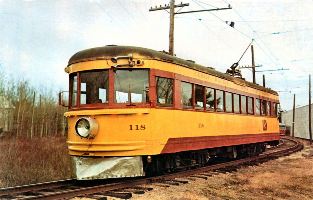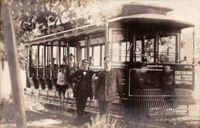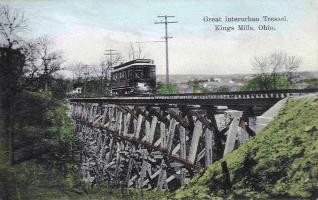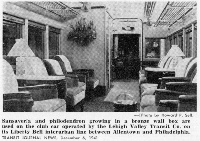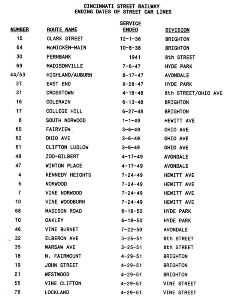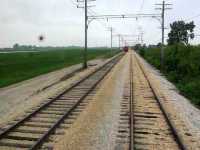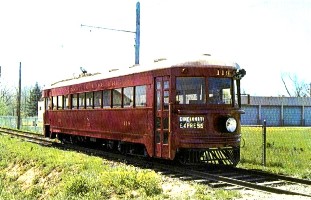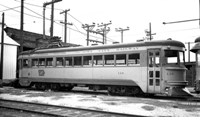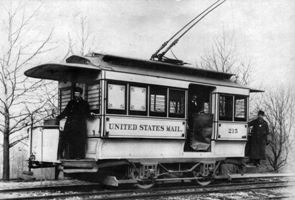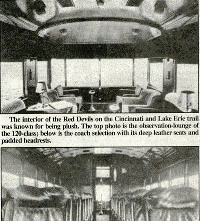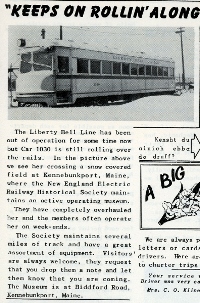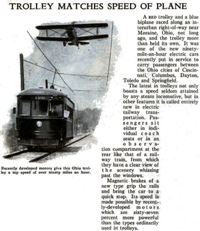“The Interurban Era”
Ohio Electric Railway: The Ohio Electric Railway began operations in 1907 and
would control numerous smaller companies until its 1921 bankruptcy at which
point its subsidiaries once again became independent operations. These
interurban railroads included the Cincinnati & Hamilton Electric Street Railway;
Cincinnati & Miami Valley Traction Company; Miamisburg & Germantown Traction
Company; Dayton, Springfield & Urbana Railway; Urbana, Bellefontaine & Northern
Railway; Lima & Toledo Traction Company; Dayton & Western Traction Company;
Dayton & Northern Traction Company; Dayton & Muncie Traction Company; Fort
Wayne, Van Wert & Lima Traction Company; Columbus & Lake Michigan Railway;
Columbus, Buckeye Lake & Newark Traction Company; Columbus, Newark &
Zanesville Electric Railway; and the Columbus, Grove City & Southwestern
Railway.
Cincinnati & Lake Erie Railroad: The Cincinnati & Lake Erie Railroad, most
famous for operating its blazing fast "Red Devil" streetcars, was one of the
largest interurban railroads to ever operate in the country. Its roots date back
to the Cincinnati & Dayton Traction Company of 1925 which was a 44-mile
interurban railroad operating in southwest Ohio. In January, 1930 this line was
merged with the Indiana Columbus & Eastern and Lima-Toledo Railroad to form the
Cincinnati & Lake Erie Railroad. The C&LE was able to turn around the
misfortunes of its latter two acquisitions (the IC&E and LT) and with a sizable
base of freight traffic on a railroad that stretched over 200 miles in three
different states (Ohio, Indiana and Michigan) the system was one of the most
profitable interurbans to ever operate. Regardless the Great Depression was no
easier on the C&LE than other interurban railroads, not to mention the
encroachment of highways and automobiles. By the late 1930s the C&LE was in
serious financial trouble and by May of 1939 abandoned its remaining line
between Hamilton and Dayton.
To embark on dramatically improving passenger service and schedules, Conway
supervised the development and acquisition of a unique fleet of twenty
lightweight, high speed, power efficient, aluminum bodied bright red passenger
cars (known eventually as "Red Devils" then built by the Cincinnati Car Company.
These interurban cars embodied the latest in Art-deco styling and were equipped
with numerous amenities including leather bucket seats with headrests. Half
were built as lounges to provide parlor car first class comfort. In order to
promote the cars, the C&LE staged a race between Red Devil #126 and an airplane.
The car achieved a speed of 97 miles per hour and "won" the highly publicized
race. Unfortunately, and typical of most interurbans, considerable open country
operation was on side-of-road track and considerable urban operation was on
track embedded in town streets with turns at street corners, so the Red Devils
had to contend with automobile traffic and would rarely achieve these speeds in
normal operation. But in open country, particularly existing on the Springfield
-Toledo division, they operated up to ninety miles per hour if behind schedule.
The Red Devils were 43'9" long, 11'4" high and weighed a low 22 metric tons
versus a typical 1920s large steel interurban 55' long and 14' high and 40 to
50 tons. The largest interurban ever constructed was built by St. Louis Car at
67' and 70 tons. Cincinnati Car Company designed new low profile trucks for
the Devils to allow them to sit lower. The new truck also turned out to be
good riding at speed on the interurban's relatively rough track with light 80
and 90 lb rail. Cincinnati designated them as their ABC74-D truck.
Waterville , Ohio - The news in 1907 that the Lima-Toledo Traction Company
was planning an interurban electric train line through the village brought
great excitement. Rail cars would reach Toledo from Waterville in the
miraculous time of 20 minutes. The longest reinforced concrete bridge would be
built at the historic site of Roche de Boeuf. In spite of assurances that the
historic rock would not be desecrated in any way, it soon became apparent that
a portion of the rock would be blasted away for a bridge support. The outraged
citzens felt betrayed. As time went on tempers cooled and the beauty of the
Roman aquaduct design became a favorite of artists and picnickers alike. For
30 years the red interurban cars raced across the bridge, one actually winning
a race against an airplane in 1930, rocketing along at nearly 100 miles an
hour. In 1937 the railway went out of business. Today, the grand old bridge
stands as an icon of Waterville history and a testament to engineering
innovation.
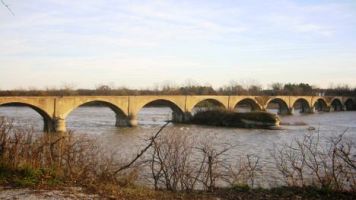
The Interurban Bridge at Waterville (click photo to view larger)
Cincinnati Car Company or Cincinnati Car Corporation was a subsidiary of Ohio
Traction Company. It designed and constructed interurban cars, streetcars
(trams) and (in smaller scale) buses. It was founded in 1902 in Cincinnati,
Ohio. In 1928, it bought the Versare Car Company. The company was among the
first to make lightweight cars. Its chief engineer Thomas Elliot designed the
curved-side car, a lightweight model that used curved steel plates (not
conventional flat steel plates) in body construction. Instead of the floor,
the side plates and side sills bore the bulk of the weight load. Longitudinal
floor supports were no longer needed, which made the cars lighter than
conventional cars. The first cars of this type were sold in 1922. For instance,
the Red Devil weighted only 22 tons. Curved-side cars were also called "Balanced
Lightweight Cars".
In 1929, the company designed new lightweight partially aluminum low profile
high-speed coaches for the electrified Cincinnati and Lake Erie Railroad
interurban that operated between Cincinnati, Dayton, and Toledo. Twenty were
purchased, painted bright red, and called Red Devils by the C&LE. These
interurban cars, whose open country speed could reach 90 mph (140 km/h)
Template: Convert/track/abbr/on, were a forerunner of today's high-speed trains.
Both the carbodies and new design small wheel low ridingtrucks were well
adapted for high-speed running on light rail rough track. In 1939, the C&LE
abandoned operation, and the Red Devils were sold to the CRANDIC interurban in
Iowa and to the Lehigh Valley Transit in Pennsylvania. They continued to
operate successfully and well into the 1950s. |

